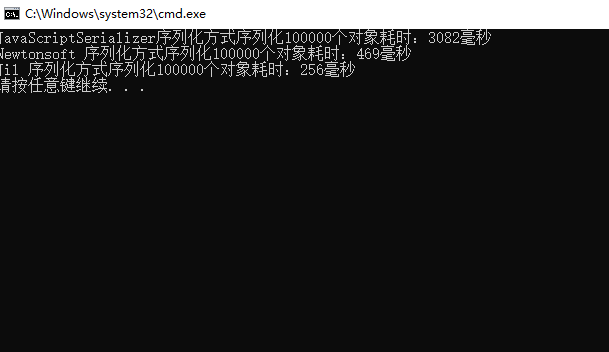前言:作为开发人员,对象的序列化经常用到,特别是在现在前后端分离 采用json 交互 ,就将原来用过的几种方式总结了下,也算是做一个记录,顺便做了下性能测试。
1:内置 JavaScriptSerializer
2:常用 Newtonsoft.Json.dll
3:第3方 Jil https://github.com/kevin-montrose/Jil
using Jil; using Newtonsoft.Json; using System; using System.Collections.Generic; using System.Diagnostics; using System.IO; using System.Web.Script.Serialization; namespace csDemo { class Program { static void Main(string[] args) { var sp_script = new Stopwatch(); //模拟数据源 默认10w var dataLsit = GetData(); #region JavaScriptSerializer 添加 System.Web.Extensions引用 sp_script.Start();//开始计数 var js = new JavaScriptSerializer { MaxJsonLength = Int32.MaxValue //设置为int的最大值 }; js.Serialize(dataLsit); sp_script.Stop(); Console.WriteLine("JavaScriptSerializer序列化方式序列化" + dataLsit.Count + "个对象耗时:" + sp_script.ElapsedMilliseconds + "毫秒"); #endregion #region Newtonsoft.Json.dll sp_script.Restart();//停止时间间隔测量,将运行时间重置为零,然后开始测量运行时间。 JsonConvert.SerializeObject(dataLsit); ; sp_script.Stop(); Console.WriteLine("Newtonsoft 序列化方式序列化" + dataLsit.Count + "个对象耗时:" + sp_script.ElapsedMilliseconds + "毫秒"); #endregion #region Jil 序列化 取出数据 output.ToString(); sp_script.Restart(); using (var output = new StringWriter()) { JSON.Serialize(dataLsit,output ); } sp_script.Stop(); Console.WriteLine("Jil 序列化方式序列化" + dataLsit.Count + "个对象耗时:" + sp_script.ElapsedMilliseconds + "毫秒"); #endregion } // 测试模拟数据源 length 默认参数10w public static dynamic GetData(int length=100000) { var lstRes = new List<dynamic>(); for (var i = 0; i < length; i++) { var data = new { Name = "张三" + i, Age = 20, IsChild = i % 5 == 0 ? true : false, Test1 = DateTime.Now, Test2 = i.ToString(), Test3 = i.ToString(), Test4 = i.ToString(), Test5 = i.ToString(), Test6 = i.ToString(), Test7 = i.ToString(), Test8 = i.ToString(), Test9 = i.ToString(), Test10 = i.ToString() }; lstRes.Add(data); } return lstRes; } }

总结:使用过程中发现GetData方法 使用dynamic (开始使用实体类) 效率反而快一点。 特别是 Jil 更明显。
Jil 学习地址:
https://github.com/kevin-montrose/Jil
https://www.dotnetjalps.com/2015/10/convert-c-object-into-json-and-vice.html
附加 webapi :使用Jil提升Json序列化性能
https://blog.csdn.net/sqqyq/article/details/51692342
注意:jil 对序列化类型有要求:(如果是object 或者是dataset 不支持) 时间需要自定义 建议时间数据转换string 默认的格式 yyyy-MM-dd hh:mm:ss
Supported Types
Jil will only (de)serialize types that can be reasonably represented as JSON.
The following types (and any user defined types composed of them) are supported:
- Strings (including char)
- Booleans
- Integer numbers (int, long, byte, etc.)
- Floating point numbers (float, double, and decimal)
- DateTimes & DateTimeOffsets
- Note that DateTimes are converted to UTC time to allow for round-tripping, use DateTimeOffsets if you need to preserve timezone information
- See Configuration for further details
- TimeSpans
- See Configuration for further details
- Nullable types
- Enumerations
- Including [Flags]
- Guids
- Only the "D" format
- IList<T>, ICollection<T>, and IReadOnlyList<T> implementations
- IDictionary<TKey, TValue> implementations where TKey is a string or enumeration
- ISet<T>
额外笔记:
css 学习网址 :https://www.zhangxinxu.com/wordpress/2012/09/css3-3d-transform-perspective-animate-transition/
js:http://www.ruanyifeng.com/blog/archives.html
工作记录:
页面导入exel 建议使用 js-xlsx
) 提交到后台在逻辑判断 。2次请求改成一次请求,减少中间过程序列化反序列。
js-xlsx:https://www.cnblogs.com/liuxianan/p/js-excel.html